|
The most popular rear end around is no doubt the Ford 9 inch unit It is used by restorers, street rodders and racers alike, regardless of what brand of car the axle is going in. It has more reputation than it deserves due to the incredible amount of aftermarket parts available for it …
but lets start with a little history and add the aftermarket ( Drag-Racing ) info .
|
|
History
|
|
Axle Bearing sizes ( non floater )
|
|
Small Ford – Stock ID
|
1.378 x 2.834
|
|
|
Small Ford – Aftermarket
|
1.531 x 2.834
|
28 spline
|
|
Small Ford – Aftermarket
|
1.562 x 2.834
|
31 spline
|
| Big Ford |
1.531 x 3.150
bearing #88128-RA
|
28 spline-stock |
| Big Ford |
1.562 x 3.150
strange bearing # A1021(ball), timken set-20 (roller)U399a and U365L
|
31 spline-stock
35 spline |
| Big Ford |
1.618 x 3.150
|
40 spline |
| Big Ford |
1.625 x 3.150
|
40 spline |
|
Big Ford
|
1.771 x 3.150
|
40 spline |
|
Mark Williams / Strange Engineering
|
1.774 x 3.347″
|
40 spline |
|
Strange Engineering
|
1.968 x 3.543″ double row
|
40 spline |
|
Strange Engineering / 2 piece axles
|
1.968 x 3.543″ double row
|
40 spline |
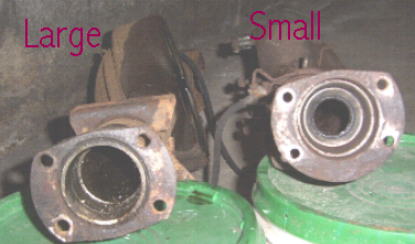
|
|
Axle Sizes ( spline )
|
| spline |
HP
|
axle diameter |
bearing ID |
gun-drilled |
|
| 28 |
|
1.208″ |
1.504″1.562″ |
|
stock |
| 31 |
|
1.291″ |
1.562″ |
|
stock |
| 33 |
500 HP Race axles |
1.333″ |
1.530″ or 1.562″ |
|
Aftermarket |
| 35 |
1000 HP Race axles |
1.500″ |
1.530″ or 1.562″ |
11/16 (optional) |
Aftermarket 45-degree pressure angle and OEM type splines |
| 40 |
|
1.708″ |
1.771″ |
7/8 or 1.125 (optional) |
Aftermarket spools and cases 45-degree pressure angle |
|
| 1.562″ Strange aftermarket |
|
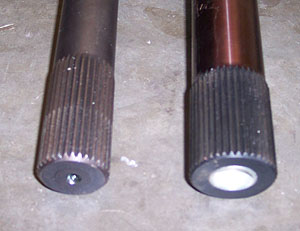
33 spline and 40 spline gun drilled axles
|
Cases (center sections , Pumpkins)
|
|
Some standard cases are also machined to take the larger 3.063”(the C7AW-G mainly) side bearings, most cases however (including N cases) will take the 2.892” side bearings. Aftermarket spools and cases are available that accommodate even larger bearings-3.250″ and 3.812″, The carrier with the 3.063″ larger side bearings is the C7AW-G marked single ribbed case, it came from a late 60’s Galaxies
case C4AW-4025-C may also be a large bearing single ribbed case.

stock, N- nodular (stronger material) and WAR( 2 ribs but stock material)

Mark Williams (with3.812″ bearings), Strange (with stock large 3.063″ bearings) and stock (2.892″)
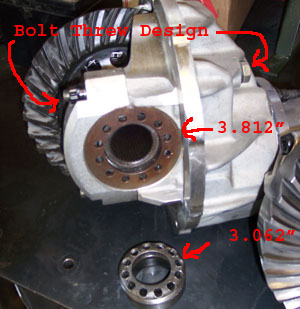
Large side bearings 3.812″
|
|
Side Bearings ( differential )- (Timken Part #)
|
| O.D. inches (housing) |
I.D. inches (spool) |
Bearing/Cone |
Race/Cup |
spline
|
|
| 2.892” |
1.625″ |
TLM501349 |
TLM501310 |
28 , 31 |
stock |
| 2.892” |
1.781″ |
TLM012949 |
TLM102910 |
28 , 31 , 33 , and MW 35 * |
stock |
| 3.063” |
1.781″ |
LM603049 |
LM603011 |
33 and 35 * |
stock |
| 3.250″ |
2.001″ |
LM104949
TLM104949 |
LM104911
TLM104911 |
33 and 35 |
Aftermarket |
| 3.812″ |
2.001″ |
|
|
40 spline |
Aftermarket |
| 3.812″ |
2.25″ |
|
|
40 spline |
|
| 4.00″ |
|
|
|
40 spline |
Ultra – case |
| |
|
* note spool wall is very thin on 35 spline |
|
|
* Why do 35-spline shafts require a 3.250” bore case?
When upgrading to a 35-spline shaft, in a 9”Ford, it is necessary to increase the case bore size to3.250” in order for the carrier (locker/spool) to have enough strength at the bearing journal. When a 35-spline spool is designed to fit into a 3.0625” or 2.891” bore case, the bearing journal thickness is extremely thin- inevitably resulting in distortion or failure at the bearing journal. In addition, a vehicle that requires a 35-spline shaft is bound to break an OEM case (2.891”/3.0625” bore), leaving you to purchase another case while being stuck with a substantially weaker spool. We could easily use a 35-spline spool that would fit into a stock bore case; however, our goal is to find the best solution for our customers the first time, which will save you time, money and grief in the long run.
|
|
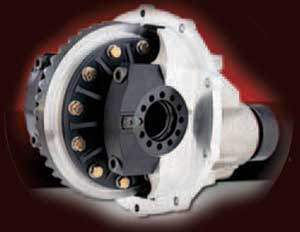
|
The 12-bolt / 9 inch drop-out caseis
The 12-bolt pinion is closer to the the center of the ring gear, in comparison to a 9” gear, making the 12-bolt 3% more efficient than a 9” rear ( 9” pinion is 2.250” below the center of the ring gear; compared to a 1.50” drop for12-bolt). Besides being more efficient, the fully assembled unit is 8-9 pounds lighter than a comparable aluminum 9”assembly
|
|
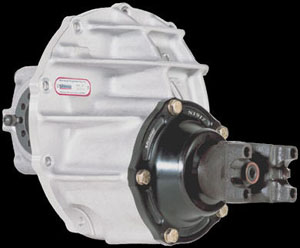
|
Lightweight Aluminum Package
(up to 650 hp, Case – 13.50 lbs) |
|
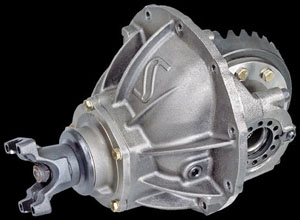
|
S-Series Package
(up to 700 hp, Case – 26.70 lbs) |
|
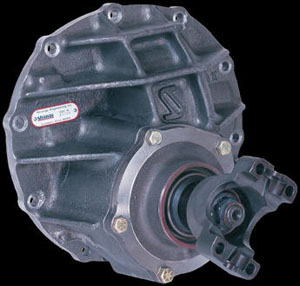
|
Pro-Iron Package
(700 hp & up, Case – 33.50 lbs)
3.06″ / 3.25″ side bearings |
|
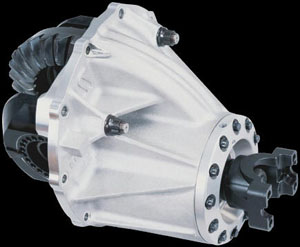
|
Bolt threw Case Package Strange and MW
(850+ hp, spool only)
9 “and 9,5″ 3.25″ / 3.812” side bearings
|
|

|
Live Axle – top loader ( 9″, 9.5″ , 10″ , 10.5″ , 11″ , 12″ 12.5″ )
Strange, MW, Chrisman note : up to $20,000.00
|
|
|
|
Pinion Supports
|
|
Pinion Bearings ( O.D. inches) – (Timken Part # ) –
Timken bearing interchange guide
|
| |
rear Dia |
front Dia |
seal |
front- cone |
front – cup |
rear – cone
|
rear – cup
|
rear bearing OD |
| Stock |
1.312.” |
1.312.” |
7044NA |
TM88048 |
TM88010 |
|
|
|
| Stock – Daytona Style |
1.312.” |
1.312.” |
7044NA |
TM88048 |
TM88010 |
HM89443 |
HM89410 |
3.0 OD X .906 wide |
| Large Pinion (35 spline) |
1.875″ |
1.5 “ |
472015 |
2788 |
|
HM804846 |
HM804810 |
3.75 OD X 1.187 wide |
| Large Pinion Ball Bearing (35 spline) |
1.875″ |
1.5 “ |
|
|
|
|
|
|
| Large Pinion Custom (35 spline) |
1.875″ |
1.5 “ |
|
|
|
|
|
|
| Fuel Pinion (40 spline) |
|
|
|
|
|
|
|
|
| |
bearing size guide |
pinion pilot bearing – R1535-TAV |
| |
Seal (28 spline) RDS55074 |
|
|
Daytona pinion supports are found in conjunction with N cases, they have the same size outer bearing as the standards supports, but the inner bearing is much larger, and the inner webbing much stronger.
|
|

stock and larger stock ( Daytona ) pinion bearings
|
|
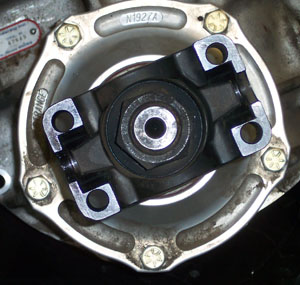
35 spline pinion support , yoke and nut
|
|
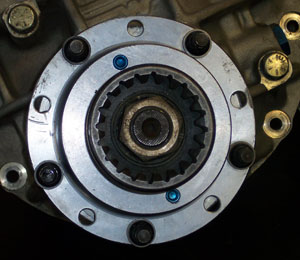
Aftermarket pinion support ( 10 bolt ) , this support has larger bearings and
separate chamber for oil supply to pinion bearings
|
|
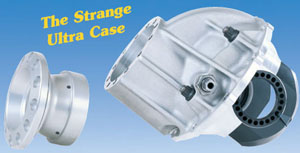
even larger pinion support but requires special case
(NOTE side load bolt on case )
|
|

|
|
Top row : Large (35 spline) PRO Gear
Bottom row : Standard (28 spline) Pinion with Daytona style pinion support
|

9″ large pinion (not stock) , 10″ and 12″ |
Pro Gears
|
|
Pro gears are made from 9310 and then heat treated. It is a softer alloy than the 8620 Street gears.
The softer 9310 alloy allows the gear to absorb higher impact loads that are generated in drag racing without developing cracks.
A harder 8620 street gear could shatter under the same loads.
As a side effect the “Pro” gears are not the best choice for street use as they will wear faster.
Also available in the “Pro” gears is a large pinion with a 35 spline shaft for high powered applications.
This requires a bearing change in the pinion support as well as a 35 spline pinion yoke.
Gears termed 9-1/2″ are also available for the 9″ thirdmember. They offer a slight strength advantage over a standard 9″ gear.

A– 10 bolt spool ( scalloped )- 20 bolt ring gear B– 20 bolt spool – 10 bolt ring gear C– 20 bolt ring gear ( 10@ 7/16 NF ,and 10@ 1/2 NF )
|
|
Big Gears ( 9.5″ – 10″ )
|
|
10 inch gears use a .100 shim for a baseline
– MW sells a different carrier bearing assy for it
– strange sells a spacer assy to use a 10 inch gear in a ultra case.
10 inch ring gears measure about 9.375
9.5 inch ring gears measure about 9.250
|
|
Wheel Studs
|
|
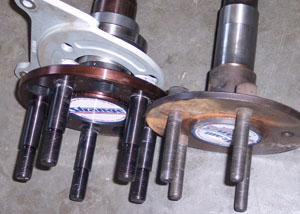
5/8 Studs 1/2 inch studs
|
|
Ford 9″ or any other Axle Housing
General Information
|
Now for my Rant:
Daily, I get calls on rear end pricing and design
“My friend has a 10-bolt rear with 28 spline axles etc… and he has run for years and never broke anything”
Remember, everything bends and flex’s with a force applied …. Someone with a light duty, very flexible rear-end , suspension or frame can get away with that
….OK, what is their 60′ times … A light weight rear (or any other frame component) can flex and absorb energy delaying any forward movement of the car
….Put a very large torque wrench on your rear wheel and pull hard enough to lift the front of your car off the ground
….How much have you bent the axles (maybe 1/2 a turn?)
Or, imagine if you take your rear end in a vise and get your buddies over … or even tie the other end to a horse … pull as hard as you can …any deflection ?
….Of course (maybe only a few thousand of an inch) … Now add 500 horses … More deflection ? Of course (maybe an inch)
…. Sure, but how long would that take to wrap up the rear of the car at the starting line at the race track … Say a tenth of a second maybe 2/10
…. You need to visualize what is going on. We are not only trying to get down the track safely but quickly … Spend your money wisely!
Basic rules – in order (after safety):
Stiffer is better … Lighter is better … More horse power is good … Aerodynamics help
And, when applied to rear end construction
Narrower housing (and axles) are stiffer than wide
Larger diameter axles are stiffer than small
Anything to stiffen the housing is good – a back brace; reinforcing the ladder/4link brackets
Note: this is much easier on sheet metal housings Dodge/Ford/Pontiac-Olds than cast housings 10″, 12″ Dana
Larger bearings have less deflection than small
Steel caps deflect less than iron
5/8″ wheel studs are stiffer than 1/2″
Bigger pinions twist less than small – especially on lower numerical gear ratios (3.90 verses 5.38)
A steel drive shaft twists less than an aluminum shaft; moly and carbon fiber are even better
Note: Another common situation is upgrading one component that brings down the project
Example: Upgrading a light weight rear-end to large spline axles and suddenly the pinion breaks,
or drive shaft , or transmission … A consistent 10 second bracket car becomes a nightmare 9 second car.
|
| Properly reinforced housings |
|
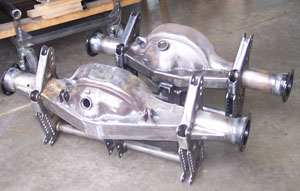
|
| NOT reinforced housing (can you imagine how much this deflects on a run) |
 |
| Ford 9″ housings (top – hotrod, bottom – drag race) |
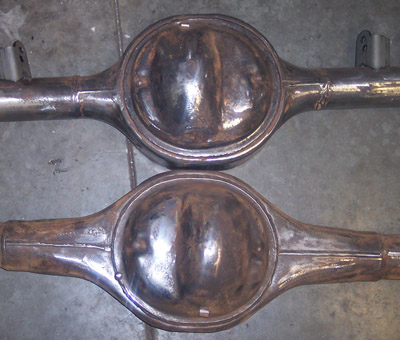 |
 |
| after powder coating |
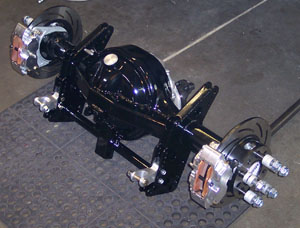 |
| Ready to go |
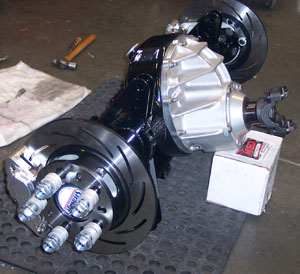 |
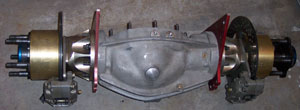
Aftermarket (Mark-Williams) aluminum reinforced housing
With Full Floater Axles (8000.00$ +) |
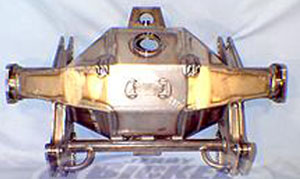
state of art reinforced housing chrome moly(3000.00$) |
|
|
Ford 9 1/2″ Information
|
|

|
|
9 3/8″ ring gear housing (sometimes called a 9 1/2″ Ford carrier -31 spline )
They appear to have come in the larger Lincoln and Mercury vehicles.
Note casting number C8AW-4668-B on pinion support and the double ribs (spaced further apart) with the end bent down on one
Most parts from these rears do not interchange with the 9 inch carriers. They can be installed in a 9″ housing if the housing is notched
for the wider gear and the gasket for the 9 3/8″ is used (bolt pattern is supposedly the same).
|
|
Axle Designs
|
Flange Axle Design – The most common flange axle design has a single piece axle, flange and shaft. The axle bearing has a press fit on to the axle shaft and a bearing lock ring is then pressed on behind the bearing. Housing ends are welded to the housing tube and the bearing slips into the housing end. The bearing is then retained by the caliper mounting bracket. Wheel studs are installed in the flange of the axle where the wheel bolts directly to the outside of the axle flange. With this design the axle and axle bearings must support not only the vehicle’s weight and torsional loads, but also the bending loads from acceleration (rear wheels try to “toe-in” during acceleration).
Safety – In the event of an axle failure the axle along with the wheel and tire can separate from the vehicle. In the case of a break outboard of the bearing, the wheel will definitely come off. A break inboard of the bearing and the wheel will stay on only until the caliper mount breaks and the bearing is free to come out of the housing end. This will also take out the rear brakes and the caliper and brake lines will be torn off.
Full Floater Design -The full floater design incorporates a hub with a bearing installed in each end. Wheel studs are installed into this hub and the assembled hub is then slipped on to the floater spindle. The floater spindle is then welded to the housing tube. The floater spindles are tubular and are large enough for the axle shaft to pass through. The drive plate is splined in the center and slides over the wheel studs and seats against the hub. The axle shaft is splined on both ends, one end engages the drive plate and the other end engages spool in the third member. With a full floater the axle shaft only sees torsional loads since the wheel and tire are bolted to the floater hubs, which are independent of the axle shaft. All other loads are taken in the hubs and floater spindles
Safety – In the event of an axle failure the wheel and tire will remain with the vehicle (as stated earlier the axle is independent of the flange and hub which are mounted on the floater spindle). The rear brakes would not be affected by axle breakage.
Live Axle Design – With this design the axle shaft is a large diameter, thin wall tube and becomes more of a structural member. The shaft is splined in the center to engage the spool and splined on both ends to accept a splined flange on each end. Both ends have a threaded area for the flange retaining nut. Most live axles use a single tapered roller bearing on each end, which must be preloaded with the flange retaining nuts during assembly. This design is most commonly found in Top Fuel car applications.
Safety – In the event of an axle failure (unlikely due to the size of the axle) the wheel and tire would also stay with the axle housing ends. Read More
|
| Note: The above information primarily addresses strength. Generally speaking, wear is not a main concern on Drag race vehicles because of their low mileage. Our main concern after safety is stiffness. Example: If you have a larger spline axle (think diameter), the number of splines is usually not a concern. The strength of a 35 or 40 spline would not be a problem. However, the twisting of a larger diameter shaft will be less and result in a quicker accelerating car. The axle may weigh more unless it is gun drilled which removes material from inside the axle.
So as you design your rearend keep in mind : 1) Safety 2) Weight 3)Stiffness 4)Strength 5)Wear – Maintenance 6)Cost
|
| Outside Lock U-Joints |
|
|
| Series |
Width |
Cap |
|
| 1210 |
2.438 |
1.062 |
|
| 1310 |
3.219 |
1.062 |
|
| 1310 BC (Ford) |
3.219 |
2 @ 1.062 (shaft) 2 @ 1.125 (pinion) |
|
| 1330 |
3.622 |
1.062 |
|
| 1330 BC (Ford) |
3.622 |
2 @ 1.062 (shaft) 2 @ 1.125 (pinion) |
|
| 1350 |
3.622 |
1.188 |
|
| 1410 |
4.188 |
1.188 |
|
| 1480 |
4.188 |
1.375 |
|
| Inside Lock U-Joints |
|
|
| 3RL (S44 GM type) |
2.556 |
1.125 |
|
| 7260 (Dodge) |
2.125 |
1.078 |
|
| 7290 |
2.622 |
1.126 |
|
|
|
7260 to 7290 U-joint
TRW part #……….. 20226.
Precision ……………347.
Mancini Racing…… 5-527X
Auto Zone ……….. 2-0527
NAPA …………….. NUJ240-0369
|
|
Hypoid Distance:
ford 9″ and 8″ = 2.25″
ford 8.8″ = 1.5″
chevy 12 bolt = 1.5″
Dana 44,50 = 1.5″
Dana 60,70,80 =1.125″
|
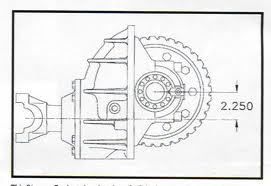 |
 |
 |































